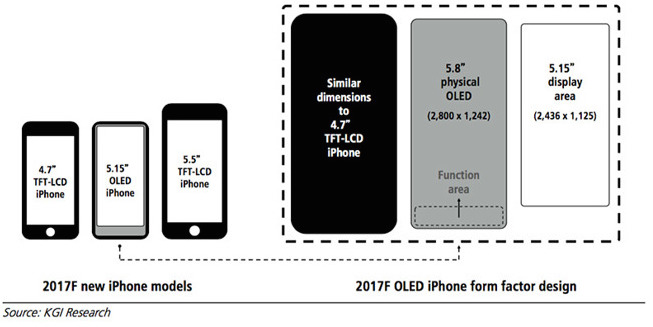With 2017 already in full swing, the makeup of Apple’s 2017 iPhone lineup is finally starting to crystallize. According to a fresh report from the Nikkei Asian Review, Apple later this year will release three brand new iPhone models, with two being incremental iPhone 7s updates and the third being the highly anticipated iPhone 8.
While the iPhone 7s and iPhone 7s Plus will undoubtedly feature improved camera technology and welcome hardware improvements underneath the hood, there’s no denying that the real star of the show will be Apple’s next-gen iPhone 8. Said to come packed with improved battery life and an edgeless OLED display, Nikkei’s sources relay that the iPhone 8 will sport a 5.8-inch display.
The upcoming iPhone, to be launched this fall, will come in three configurations — two with liquid crystal displays and one with a 5.8-inch organic light-emitting diode display. By adding more large-screen options to the lineup to meet growing demand for BIG, Apple intends to raise the average iPhone price, which has already gone up by about 10% in the past three years to nearly $700.
Nikkei’s note is worth highlighting because it clears up any existing confusion regarding the size of Apple’s iPhone 8. If you recall, the publication just a few months ago relayed that the iPhone 8 might feature a 5.5-inch display. Of course, given Apple’s tendency to test multiple prototypes before deciding on a final form factor, it’s not the least bit surprising that we saw some minor inconsistencies about the iPhone 8 design from various analysts and supply chain sources.
Likely to shatter all existing sales records, the iPhone 8 will mark the first new iPhone form factor since Apple released the iPhone 6 nearly three years ago. Specifically, the device will feature extremely subtle bezels, enabling Apple to fit a display with 5.15-inches of usable space into a device that’s about the same size as Apple’s 4.7-inch iPhone 7.
As a quick illustration of what Apple has planned, reputed KGI Securities analyst Ming-Chi Kuo published the following image about two weeks ago.

Aside from a nearly edgeless display, it will be interesting to see what Apple plans to do with the “Function area” pictured above. While this particular aspect of the iPhone 8 remains hazy, it stands to reason that the Function area will be similar in operation to the TouchBar Apple introduced on the MacBook Pro. We’ve also seen indications that the Function area will feature Touch ID-esque functionality embedded right into the display itself, thereby allowing Apple to remove the home button as we currently know it.
As we highlighted last week, an industry report relays that Apple has figured out a way to embed a sensor into the iPhone 8 display that relies upon ultrasound instead of a user’s fingerprint for user identification purposes.
Additionally, it will be interesting to see if Apple relies upon facial recognition technology tocompliment whatever type of finger-based verification system it’s working on. Hardly a well-kept secret, Apple over the past few months has been bolstering its facial recognition IP, most recently acquiring Realface, an Israeli technology company with facial recognition software so reliable and sophisticated that it can purportedly be used as a foundation for mobile-based biometric authentication.
Coupled with many of the iPhone 8 rumors we’ve seen regarding augmented reality functionality, it’s becoming increasingly clear that Apple’s next flagship iPhone may be far more advanced than most people realize.








